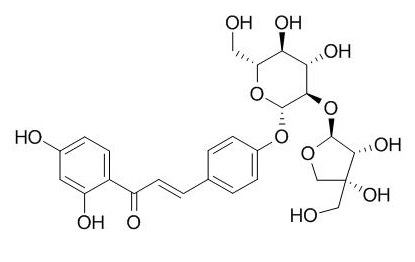Isoliquiritin apioside
Isoliquiritin apioside with marked potential to combat oxidative stress-induced genotoxicity.
Inquire / Order:
manager@chemfaces.com
Technical Inquiries:
service@chemfaces.com
Tel:
+86-27-84237783
Fax:
+86-27-84254680
Address:
1 Building, No. 83, CheCheng Rd., Wuhan Economic and Technological Development Zone, Wuhan, Hubei 430056, PRC
Providing storage is as stated on the product vial and the vial is kept tightly sealed, the product can be stored for up to
24 months(2-8C).
Wherever possible, you should prepare and use solutions on the same day. However, if you need to make up stock solutions in advance, we recommend that you store the solution as aliquots in tightly sealed vials at -20C. Generally, these will be useable for up to two weeks. Before use, and prior to opening the vial we recommend that you allow your product to equilibrate to room temperature for at least 1 hour.
Need more advice on solubility, usage and handling? Please email to: service@chemfaces.com
The packaging of the product may have turned upside down during transportation, resulting in the natural compounds adhering to the neck or cap of the vial. take the vial out of its packaging and gently shake to let the compounds fall to the bottom of the vial. for liquid products, centrifuge at 200-500 RPM to gather the liquid at the bottom of the vial. try to avoid loss or contamination during handling.
Biochemical Systematics and Ecology2018, 81
Microchemical Journal2018, 137:168-173
Antimicrob Agents Chemother.2020, AAC.01921-20.
Evid Based Complement Alternat Med.2017, 2017:1401279
Biorxiv2019, 10.1101
Plants (Basel).2021, 10(6):1119.
Food Res Int.2018, 106:909-919
Appl. Sci. 2021, 11(10),4666.
Journal of Ginseng Research2022, j.jgr.2022.09.005.
Bioorg Med Chem.2018, 26(14):4201-4208
Related and Featured Products
Toxicol In Vitro. 2009 Jun;23(4):680-6.
Evaluation of antigenotoxic activity of isoliquiritin apioside from Glycyrrhiza glabra L.[Pubmed:
19490840]
Prevention of manifestation of events characteristic of carcinogenesis is being emphasized a rational strategy to combat cancer. Reactive oxygen species (ROS) play an important role in tumor initiation through oxidative damage of DNA.
METHODS AND RESULTS:
In search for lead molecules in cancer chemoprevention from natural products, a fraction 'Rlicca' isolated from Glycyrrhiza glabra was studied for modulatory effect against hydrogen peroxide and 4-nitroquinoline-N-oxide induced genotoxicity in Escherichiacoli PQ37 using SOS chromotest and in human peripheral blood lymphocytes using the Comet assay. The fraction 'Rlicca' at a concentration of 191 microM decreased the SOS inducing potency (SOSIP) of hydrogen peroxide (1.0mM) and NQO (20 microg/ml) by 83.72% and 68.77%, respectively. In the human blood lymphocytes, 'Rlicca' reduced the tail moment induced by hydrogen peroxide (25 microM) and NQO (5 microg/ml) by 88.04% and 76.64%, respectively, using the Comet assay. The spectroscopic data of 'Rlicca' fraction revealed it to be Isoliquiritin apioside, a chalcone oligoglycoside.
CONCLUSIONS:
This is the first report of Isoliquiritin apioside with marked potential to combat oxidative stress-induced genotoxicity.
Front Pharmacol . 2018 Dec 10;9:1455.
Isoliquiritin Apioside Suppresses in vitro Invasiveness and Angiogenesis of Cancer Cells and Endothelial Cells[Pubmed:
30618749]
Abstract
Several components isolated from Glycyrrhizae radix rhizome (GR), including glycyrrhizin, liquiritin, and liquiritigenin, have been shown to induce cancer cell death and inhibit cancer metastasis. Isoliquiritin apioside (ISLA), a component isolated from GR, has been effective for treating tetanic contraction and genotoxicity. However, the effects of ISLA on the metastasis and angiogenesis of malignant cancer cells and endothelial cells (ECs) have not been reported. In this study, we found that up to 100 μM ISLA did not affect cell proliferation but efficiently suppressed the metastatic ability of HT1080 cells, as assessed by scratch-wound migration, Transwell® migration, scratch-wound invasion, Transwell® invasion, and three-dimensional spheroid invasion. ISLA significantly decreased phorbol 12-myristate 13-acetate (PMA)-induced increases in matrix metalloproteinase (MMP) activities and suppressed PMA-induced activation of mitogen-activated protein kinase as well as NF-κB, which are involved in cancer metastasis. In addition, ILSA treatment reduced the production of pro-angiogenic factors in HT1080 cells, including MMP-9, placental growth factor, and vascular endothelial growth factor under normoxia as well as hypoxia conditions, by impairing the hypoxia-inducible factor-1α pathway. We also found that the abilities of human umbilical vein ECs to migrate across the Transwell® and to form tube-like structures were significantly reduced by ISLA treatment. Moreover, using the chorioallantoic membrane assay, vessel formation with or without vascular endothelial growth factor was significantly suppressed by ISLA. These results suggested that ISLA possesses anti-metastatic and anti-angiogenic abilities in malignant cancer cells and ECs, with no cytotoxicity. ISLA may therefore be a safe and effective lead compound to develop anti-cancer drug for limiting the spread of primary tumors to distant organs to form secondary tumors.
Keywords: HIF-1α; HT1080; MAPK; NF-κB; angiogenesis; cancer; Isoliquiritin apioside; metastasis.
Eur J Pharmacol. 2003 May 23;469(1-3):159-63.
Antitussive principles of Glycyrrhizae radix, a main component of the Kampo preparations Bakumondo-to (Mai-men-dong-tang).[Pubmed:
12782198]
We attempted to elucidate the antitussive principles of Glycyrrhizae radix, a main component of Bakumondo-to (Mai-men-dong-tang). Although the 50% methanol-eluted fraction (100 mg/kg, p.o.) caused a more than 60% reduction in the number of capsaicin-induced coughs, neither the water-eluted nor 100% ethanol-eluted fractions of water extract of G. radix had antitussive effects. The water extract of G. radix contained high levels of liquiritin, liquiritin apioside, isoliquiritin, Isoliquiritin apioside and glycyrrhizin. On the other hand, the 50% methanol-eluted fraction contained mainly liquiritin and liquiritin apioside, but not the other compounds. Liquiritin apioside (3-30 mg/kg, p.o.), but not liquiritin, isoliquiritin, Isoliquiritin apioside or glycyrrhizin, dose-dependently inhibited the number of coughs. Methysergide, a serotonin receptor antagonist, antagonized the antitussive effect of liquiritin apioside. However, the antitussive effect of liquiritin apioside was not antagonized by naloxone. Pretreatment with glibenclamide (3 mg/kg, i.p.), an ATP-sensitive potassium channel blocker, also significantly reduced the antinociceptive effect of liquiritin apioside. These results suggest that G. radix contains a potent antitussive compound, liquilitin apioside, whose antitussive effect may depend on both peripheral and central mechanisms.



